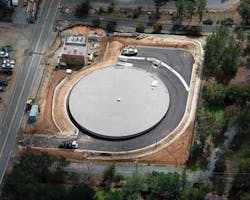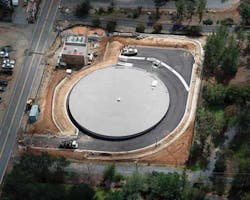By Judy Horning
Located in Southern California, the Padre Dam Municipal Water District delivers water to a population of over 103,000 residents in the eastern suburbs of San Diego. The District takes pride in providing a safe and reliable water distribution system to the communities it serves. Driven by this commitment and the need for additional fire flow capacity following the devastation of many area homes during the tragic Cedar Fire, the District replaced an existing 1.5-million-gallon (MG) water storage tank with a 2.5-MG prestressed concrete tank in the suburb of Alpine, Calif.
The existing "East Victoria" tank was a partially-buried, hopper-bottom, non-prestressed, cast-in-place concrete reservoir constructed over fifty years ago. It required continual maintenance to keep it in safe operating condition and to comply with California Department of Public Health regulations. Even though structural evaluations established that it could be retrofitted, hydraulic modeling indicated that the site required an increase of one million gallons of capacity to improve operational reliability, provide emergency storage and increase fire flow availability.
As such, Padre Dam Municipal Water District hired a project team consisting of civil and structural engineer AECOM; geotechnical consultant Ninyo & Moore; general contractor Spiess Construction Company; tank subcontractor Ward Henshaw; and tank prestressor DN Tanks.
Tank Design
After careful consideration, the District, with AECOM, determined that a 2.5-MG prestressed concrete tank offered the optimal solution for water storage at the site. The East Victoria tank floor, footings, columns, walls, and roof were all designed and constructed with concrete. With an inside wall height of 28' and a diameter of 125' the tank incorporated a 10" thick, poured-in-place corewall and a flat slab roof. The walls were constructed using cast-in-place concrete, and each section was poured full height, eliminating horizontal jointing.
Seismic Considerations
As the tank was located in California and likely to be subjected to significant seismic forces sometime over its service life, seismic design was important. Specialized seismic connections were incorporated at the wall base and top - similar to a base isolation system in essential buildings. They were designed to allow for maximum ductility under a seismic event to ensure the structure would continue to perform should the tanks undergo horizontal and vertical ground accelerations.
The tank corewalls were both circumferentially and vertically prestressed utilizing the latest in prestressing technology. Circumferential prestressing was completed by DN Tanks' strandwrapping machine, which applied the desired force to the hot-dipped galvanized, 7-wire strand with a high degree of precision to 14,950 pounds. A recording of the strand application was continuously electronically monitored and documented, ensuring that a tight tolerance of the applied force was maintained. Vertical prestressing utilized 96 1¼" diameter high-strength threadbars embedded in the wall and spaced approximately 48"on center. This elongated each of the high-strength steel threadbars with a hydraulic ram threaded onto the vertical threadbar at the top of the wall and stressed to 137.3 kips of force.
Prestressing the corewall both circumferentially and vertically yielded an efficient structure to contain the large loads produced by the stored water and the subsequent backfill and design live loads. Prestressing not only ensured an economical project but also gave the structure the strength and durability to undergo horizontal and vertical ground accelerations.
Summary
Water storage tanks are an integral part of the District's long-term program to create a safe and reliable water distribution system able to meet current regulatory compliance and improve water quality, reliability and capacity.
About the Author: Judy Horning is a marketing associate with DN Tanks.
DN Tanks is exhibiting at AWWA's ACE14 expo in Booth 1021.





